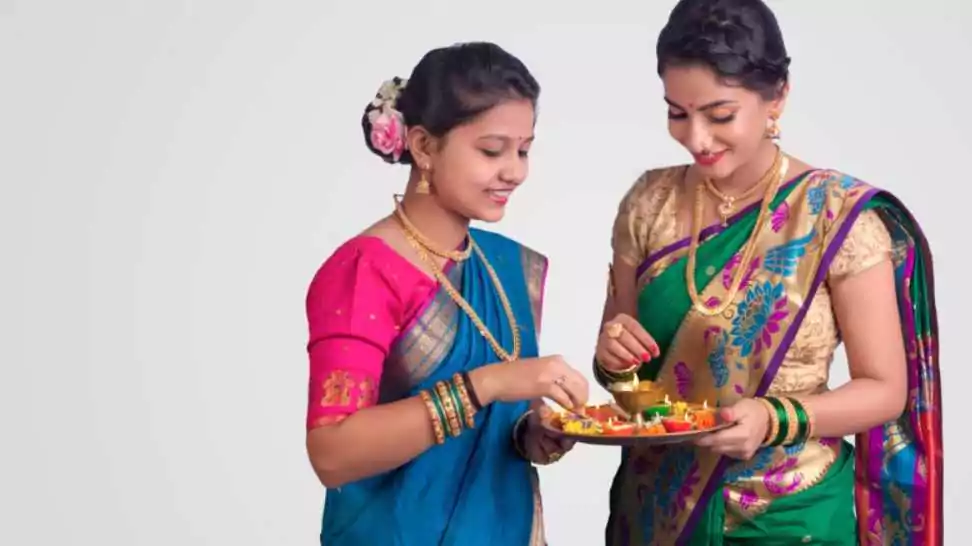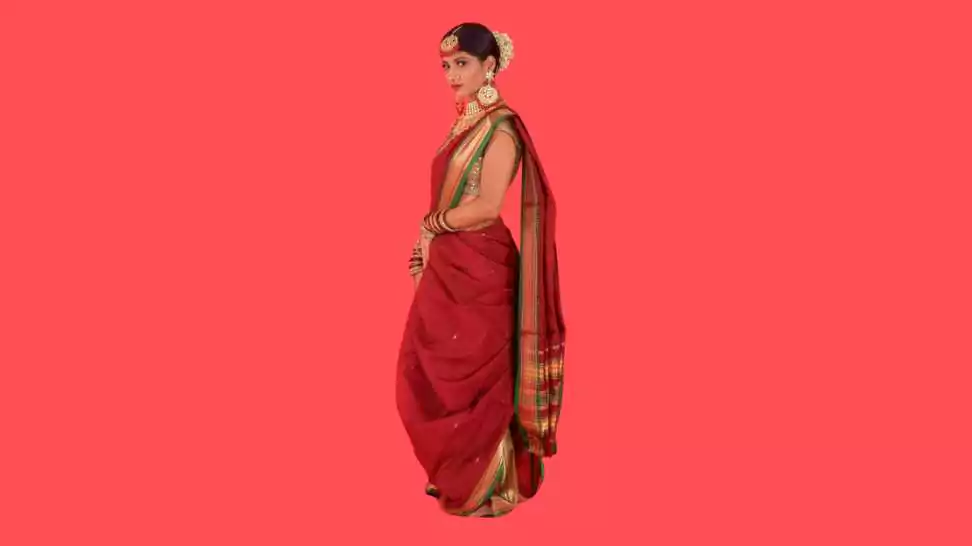How To Wear Nauvari Saree Step-by-Step?

The Nauvari saree, a quintessential emblem of Maharashtrian heritage, stands as a beacon of cultural pride and traditional elegance. This garment, whose name translates to “nine yards,” harks back to a storied past, intertwining with the rich tapestry of Maharashtra’s history and traditions. Historically, the Nauvari saree was designed for the warrior queens of Maharashtra, enabling them to ride horses and lead armies into battle without compromising their modesty or forsaking their cultural identity. This historical significance has transcended centuries, transforming the Nauvari from a battle-ready attire to a versatile garment celebrated in various traditional events and performances.
Today, the Nauvari saree is celebrated across a spectrum of occasions, from weddings, religious ceremonies, and festivals to cultural performances like the spirited Lavani dance, showcasing its adaptability and enduring appeal. The saree’s design, allowing for free movement while embodying the grace of traditional attire, makes it a unique piece in the Indian sartorial landscape.
As we delve deeper into how to wear Nauvari saree, we will explore its significance, the variety of styles it encompasses, and how it can be gracefully donned for every occasion, ensuring that the wearer not only pays homage to a rich cultural heritage but also shines in the elegance that this traditional attire brings.
1 The Basics Of Nauvari Saree
The Nauvari saree, a garment steeped in history and tradition, offers a distinctive style that sets it apart from other saree drapes in India. Its name, Nauvari, which means ‘nine yards’, hints at the length of the fabric, which is about nine yards long, nearly double the length of a typical saree. This extra length allows for a unique drape that is both traditional and functional, symbolizing the strength and valour of the Maharashtrian women. Let’s delve into the traditional versus stitched Nauvari sarees and how to select the perfect one for you.

The Traditional vs. Stitched Nauvari Saree
Traditional Nauvari Saree
The traditional Nauvari saree is draped in a manner that resembles a pair of trousers or a dhoti, with the ends tied up at the back, allowing for free movement. This drape was originally designed for the warrior queens of Maharashtra, enabling them to ride horses comfortably. Wearing the traditional Nauvari involves a series of steps that fold, tuck, and pleat the saree around the waist and legs, securing it without the need for a petticoat. This unique drape not only pays homage to the bravery of the women of Maharashtra but also accentuates the elegance and grace of the wearer.
Stitched Nauvari Saree
In response to the modern-day need for convenience and quicker dressing, the stitched Nauvari saree has gained popularity. This version simplifies the draping process by pre-stitching the saree into a trouser-like garment that can be worn easily, similar to putting on a skirt or pants. The stitched Nauvari maintains the traditional look but cuts down the time and expertise required to drape it, making it accessible to a broader audience, including those new to wearing sarees.
Choosing the Right Nauvari Saree
Selecting the right Nauvari saree involves considering the fabric, color, and pattern, which should harmonize with the occasion, your body type, and personal style.
Fabric
Choose lightweight fabrics like silk, cotton, or blends for comfort and ease of movement, especially if you are new to wearing the Nauvari. These fabrics are ideal for both traditional and stitched versions, offering a flattering drape.
Color and Pattern
The occasion dictates the color and pattern choice. Opt for vibrant colors and intricate patterns for festivals and weddings, while softer colors and simpler designs work well for casual events or daily wear. Remember, dark colors are more forgiving and slimming, while light colors and large patterns can add volume.
Wearing at Home
For those looking to practice the drape or wear the Nauvari saree at home for casual events, start with a simple, less expensive cotton saree. This allows you the freedom to experiment with the drape without the fear of damaging luxurious fabrics.

2 Step-by-Step Guide to Wearing Nauvari Saree
Preparing the Saree and Accessories
Before you begin draping your Nauvari saree, gather all the necessary items to ensure a smooth and efficient process. Here’s what you’ll need:
- Saree: The nine-yard Nauvari saree, chosen according to the occasion.
- Petticoat: Not required for the traditional Nauvari drape but needed for stitched versions if they’re not fully tailored to act as trousers.
- Blouse: A traditional, fitted blouse that complements your saree.
- Accessories: This includes jewelry (necklaces, earrings, bangles), a waist belt (optional), and flowers for your hair (optional), depending on the occasion.
- Safety Pins: Essential for securing the saree and pleats in place.
- Pre-drape Preparations:
- For the traditional saree, iron the saree neatly to remove any wrinkles. This makes the draping process smoother.
- For the stitched saree, ensure it’s adjusted according to your waist size and length for a perfect fit.
Draping the Traditional Nauvari Saree

Draping a traditional Nauvari saree can be complex, but with practice, it becomes an art form that elegantly showcases the beauty of Maharashtrian culture. Here’s a simplified step-by-step guide:
- Start with the Saree: Begin by holding the saree’s end (not the pallu) and tuck it into the waistband of your undergarments, at the center back.
- Make the First Pleats: Take the saree around your body once, and make about 5-7 pleats with the section that comes back to the front. Tuck these pleats into your waistband, ensuring they fall gracefully and evenly.
- Form the Leg Divisions: Bring the saree around your back again, and this time, take it between your legs to the front. This creates the divided dhoti look, characteristic of the Nauvari.
- Secure the Back and Front: Tuck the fabric securely at the back and adjust the front pleats so that they sit comfortably between your legs, securing with safety pins if necessary.
- Drape the Pallu: The remaining length of the saree is taken over the shoulder like a regular saree pallu, with pleats made and pinned neatly on your shoulder.
Wearing a Stitched Nauvari Saree
The stitched Nauvari saree is designed for convenience, significantly reducing the time and effort needed to achieve the traditional look.
- Step into the Saree: Like putting on trousers, step into your stitched Nauvari saree, ensuring the leg divisions are correctly aligned.
- Secure the Waistband: Pull up the saree and secure the waistband snugly around your waist, adjusting the drawstring or elastic to fit comfortably.
- Adjust the Pleats: Stitched sarees come with pre-made pleats. Adjust these pleats so they fall neatly and evenly in the front.
- Arrange the Pallu: Drape the pallu over your shoulder, adjusting it to fall gracefully. Secure it with a safety pin on your blouse to keep it in place.
3 Styling Tips for Nauvari Saree
Accessories and Footwear
The Nauvari saree’s traditional elegance is best complemented with carefully selected jewelry and footwear. These accessories not only enhance the saree’s beauty but also reflect the wearer’s personal style and the formality of the occasion.
Jewelry
- Traditional Occasions: Opt for classic Maharashtrian jewelry such as the Kolhapuri Saaj, Thushi necklaces, Nath (nose ring), and Paithani hand bangles. Gold is the preferred metal, symbolizing prosperity and festivity.
- Casual Wear: For a more subdued look, choose simpler jewelry like small stud earrings, a single bangle, or a minimalist necklace. The key is to maintain elegance without overpowering the saree’s natural charm.
- Lavani Performance: Emphasize dramatic flair with large, bold pieces. Large earrings, heavy necklaces, and an ornate Nath can complement the dynamic and vibrant nature of Lavani dance.
Footwear
- Traditional and Formal Events: Kolhapuri chappals or traditional Indian sandals with intricate work are ideal. These not only match the saree’s traditional vibe but also offer comfort for long durations.
- Casual and Performance Wear: Comfort is key. Opt for flat, comfortable sandals or even embellished juttis that provide ease of movement without compromising on style.
Hair and Makeup
The right hairdo and makeup can significantly enhance the overall look of a Nauvari saree, adding to its traditional elegance while allowing room for contemporary interpretations.
Hair
- Traditional Bun: A classic bun, adorned with flowers (typically jasmine), is timeless and perfect for formal occasions. It adds grace and complements the saree’s draping style.
- Open Hairstyles: For casual events, softly curled hair left open or half-tied can offer a more relaxed look that’s still polished.
- Braids: Intricately braided hairstyles, decorated with small flowers or traditional hair accessories, work well for performances or traditional gatherings, adding both charm and functionality.
Makeup
- Traditional Look: Emphasize bold kajal or eyeliner, a bindi, and lipstick that matches the saree’s color palette. Keep the foundation natural and highlight your cheeks with a warm blush.
- Contemporary Touch: For a modern twist, experiment with eyeshadow colors that complement the saree, along with a subtle contour and highlight to accentuate your features.
- Performance Makeup: Lavani and other performances may require more dramatic makeup. Opt for vibrant eyeshadows, heavier kajal, and bright lipstick to ensure facial expressions are visible and impactful from a distance.
4 Special Occasions and Performances
How to Wear a Nauvari Saree for Lavani
Lavani, a traditional Maharashtrian dance form known for its rhythmic beats and expressive gestures, requires attire that is both vibrant and allows for maximum movement. The Nauvari saree, with its traditional drape, provides this freedom, making it an ideal choice for performers.
- Freedom of Movement: Ensure the drape is secure, especially between the legs, to allow for the expansive leg movements Lavani is known for. The saree should be tightly tucked in at the waist, and the length adjusted to just above the ankle to prevent tripping during fast-paced steps.
- Traditional Appearance: Choose bright colors and bold patterns that stand out on stage. The saree should be complemented with traditional jewelry pieces like the Nath, large earrings, and bangles to maintain the authentic Lavani look.
- Practical Considerations: Use safety pins strategically to secure the saree in place, ensuring that it remains intact throughout the performance. Additionally, consider wearing a stitched Nauvari saree for even greater ease of movement.
Wearing Nauvari Saree for Festivals and Weddings
Festivals and weddings are occasions to showcase the most elaborate and elegant versions of the Nauvari saree, emphasizing intricate draping techniques and accessorizing to achieve a regal look.
- Elaborate Draping: For these occasions, the traditional method of draping the Nauvari saree is preferred for its majestic appearance. Consider hiring a professional or seeking the help of an experienced elder to ensure the drape is perfect, highlighting the pallu and pleats beautifully.
- Accessorizing: This is the time to bring out the best of traditional Maharashtrian jewelry, such as the Kolhapuri Saaj, Thushi, and Paithani hand bangles. Pair the saree with a matching blouse featuring detailed embroidery or embellishments for an added touch of elegance.
- Fabric and Color Choice: Opt for luxurious fabrics like silk, which not only look rich but also hold the pleats well. Colors can range from deep, traditional hues to bright, festive shades, depending on the time of day and nature of the event. Gold accents in the saree add an extra layer of opulence, suitable for such grand occasions.
5 Tips and Tricks
Everyday Wear and Practice Sessions
The Nauvari saree, while traditionally reserved for special occasions, can also be adapted for more casual wear or practice sessions. This adaptability allows individuals to connect with their cultural heritage in daily life.
- Choosing the Right Saree: For everyday wear, opt for Nauvari sarees made from lightweight, breathable fabrics such as cotton. These materials are not only comfortable but also easier to manage and drape.
- Simplified Draping: While practicing or for casual wear, you can simplify the traditional drape to reduce the time it takes to get ready. Consider using fewer pleats or opting for a stitched Nauvari saree that can be worn like trousers and paired with a simple blouse.
- Accessorizing for Daily Wear: Keep accessories minimal. A small pair of earrings or a single bangle can add a touch of elegance without being too cumbersome for everyday activities.
Maintenance and Care Tips
Preserving the beauty and longevity of a Nauvari saree requires proper care and maintenance, especially since many of these sarees are made from delicate fabrics like silk.
- Washing Instructions: Always check the care label before washing. Many Nauvari sarees, especially those made from silk or containing intricate embroidery, should be dry cleaned rather than washed at home. Cotton sarees can be gently hand washed with a mild detergent.
- Storing the Saree: Store your Nauvari saree in a cool, dry place away from direct sunlight to prevent fading. Use a muslin cloth or saree bag for storage to allow the fabric to breathe and keep moisture away. This is especially important for silk sarees.
- Avoiding Damage: Be mindful of where and how you pin your saree. Use safety pins sparingly and carefully to avoid tearing the fabric. Additionally, when wearing jewelry, ensure it does not catch and pull on the saree.
- Regular Maintenance: Iron the saree on a low heat setting or use a steamer to remove wrinkles before wearing. For silk sarees, consider placing a cloth between the saree and the iron to prevent direct heat damage.
6 Wrapping Up
This guide has journeyed through the Nauvari saree’s storied past, showcasing its significance in Maharashtrian culture as a symbol of grace and resilience. Draping the Nauvari is more than an exercise in style; it’s a connection to a rich heritage and a celebration of identity.
We encourage all to try wearing the Nauvari saree, a gesture that honors Maharashtra’s legacy while embracing a unique aspect of Indian culture. Perfect for various occasions, the Nauvari stands as a testament to the enduring elegance of traditional attire.
By stepping into the Nauvari saree, you embrace a piece of history and culture, embarking on a meaningful journey. This guide serves as a bridge to the past, inspiring a deeper appreciation for the art of draping the Nauvari saree, a path filled with pride and beauty.
Community Q&A
About This Article
This article has been viewed 127 times.



